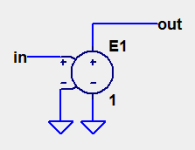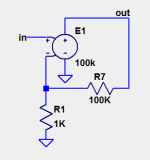Chuck D. Bones
Circuit Wizard
This is a simple one. Often times we want a unity gain buffer and for a few reasons, don't want or need an accurate opamp model. The main reason is that an accurate opamp models contain a TON of parts (some, over 100) which slows down the simulation. Especially when you have several opamps in your circuit. Here's how to simulate a unity gain buffer with one part: the voltage-controlled voltage source (VCVS). Most opamp models contain a VCVS.
Here's a unity gain buffer modeled as simply as possible:

The 1 at the lower right is the gain.
It has infinite input impedance, zero output impedance, infinite bandwidth & infinite slew rate. The output has no limits on output voltage or current. In other words, it won't saturate. For AC ananysis, this is rarely a problem. For transient analysis, sometime we can get unbelievable results. for instance, if we drive a capacitive load, the peak current could be kiloamps. We can also get incorrect output voltages. fort instance, if we drive the input below ground, the output will swing below ground as well.
Note that there are no power pins. The input and output can be referenced to ground, even in a single-supply circuit.
Now we can take it a step further. Suppose we want a simple opamp model. We just change that 1 to something larger. 100K is a reasonable value. Now keep in mind what I said about unrealistic output voltages. You can wire it for 40dB gain (100x) like this:

for AC analysis, we're still ok. But what happens if we run a transient analysis and we drive the input with 1Vp-p? The output will be 100Vp-p, which we know would never happen in a pedal with commercial opamps. VCVS's never saturate. If you're trying to simulate a circuit that saturates the opamp, then you need an accurate opamp model, not a VCVS.
Here's a unity gain buffer modeled as simply as possible:

The 1 at the lower right is the gain.
It has infinite input impedance, zero output impedance, infinite bandwidth & infinite slew rate. The output has no limits on output voltage or current. In other words, it won't saturate. For AC ananysis, this is rarely a problem. For transient analysis, sometime we can get unbelievable results. for instance, if we drive a capacitive load, the peak current could be kiloamps. We can also get incorrect output voltages. fort instance, if we drive the input below ground, the output will swing below ground as well.
Note that there are no power pins. The input and output can be referenced to ground, even in a single-supply circuit.
Now we can take it a step further. Suppose we want a simple opamp model. We just change that 1 to something larger. 100K is a reasonable value. Now keep in mind what I said about unrealistic output voltages. You can wire it for 40dB gain (100x) like this:

for AC analysis, we're still ok. But what happens if we run a transient analysis and we drive the input with 1Vp-p? The output will be 100Vp-p, which we know would never happen in a pedal with commercial opamps. VCVS's never saturate. If you're trying to simulate a circuit that saturates the opamp, then you need an accurate opamp model, not a VCVS.
